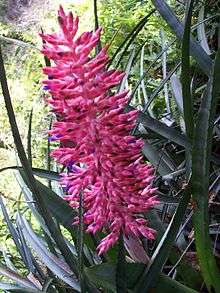Aechmea distichantha
Aechmea distichantha, the Brazilian vaseplant, or vase plant, is a bromeliad typical of Cerrado vegetation in Brazil, which is also native to northern Argentina, Bolivia, Paraguay, and Uruguay.[1][2][3][4][5] This plant is often used as an ornamental plant.
| Aechmea distichantha | |
|---|---|
 | |
| Scientific classification | |
| Kingdom: | Plantae |
| Clade: | Tracheophytes |
| Clade: | Angiosperms |
| Clade: | Monocots |
| Clade: | Commelinids |
| Order: | Poales |
| Family: | Bromeliaceae |
| Genus: | Aechmea |
| Subgenus: | Aechmea subg. Platyaechmea |
| Species: | A. distichantha |
| Binomial name | |
| Aechmea distichantha | |
| Synonyms[1] | |
| |
The following varieties are recognized:[1]
- Aechmea distichantha var. distichantha - Brazil, Argentina, Paraguay, Uruguay
- Aechmea distichantha var. glaziovii (Baker) L.B.Sm.(1943) - southeastern Brazil
- Aechmea distichantha var. schlumbergeri E.Morren ex Mez (1892) - Bolivia, Brazil, Argentina, Paraguay
- Aechmea distichantha var. vernicosa E.Pereira (1979) - Rio de Janeiro State
Cultivars
- Aechmea 'Chantichantha'
- Aechmea 'Dawson'
- Aechmea 'Distibachii'
- Aechmea 'Pacifica'
- xNeomea 'Flame'
.jpg) Flowering patch of A. disticantha
Flowering patch of A. disticantha- A. disticantha as an epiphyte.
gollark: You haven't bound your screenshot tool to printsc or something?
gollark: Spontaneously.
gollark: They would immediately implode.
gollark: Wait, what if other departments order small amounts of candles for their own use?
gollark: Ah, of course.
References
- Kew World Checklist of Selected Plant Families
- Versieux, L.M. & Wendt, T. (2006). Checklist of Bromeliaceae of Minas Gerais, Brazil, with notes on taxonomy and endemism. Selbyana 27: 107-146.
- Sant'Ana Melhem, T., das Graças Lapa Wanderley, M., Ehlin Martins, S., Jung-Mendaçolli, S.L., Shepherd, G.J. & Kirizawa, M. (eds.) (2007). Flora Fanerogâmica do Estado de São Paulo 5: 1-476. Instituto de Botânica, São Paulo.
- Martinelli, G., Magalhães Vieira, C., Gonzalez, M., Leitman, P., Piratininga, A. Ferreira da Costa, A. & Campostrini Forzza, R. (2008). Bromeliaceae da Mata Atlântica Brasileira: lista de espécies, distribuição e conservação. Rodriguésia; Revista do Instituto de Biologia Vegetal, Jardim Botânico e Estaçao Biologica do Itatiaya 59: 209-258.
- Versieux, L.M., Wendt, T., Batista Louzada, R. & das Graças Lapa Wanderley, M. (2008 publ. 2009). Bromeliaceae da Cadeia do Espinhaço. Megadiversidade 4: 98-110.
External links
- Aechmea distichantha
- Aechmea distichantha
- "Aechmea distichantha". Germplasm Resources Information Network (GRIN). Agricultural Research Service (ARS), United States Department of Agriculture (USDA).
This article is issued from Wikipedia. The text is licensed under Creative Commons - Attribution - Sharealike. Additional terms may apply for the media files.